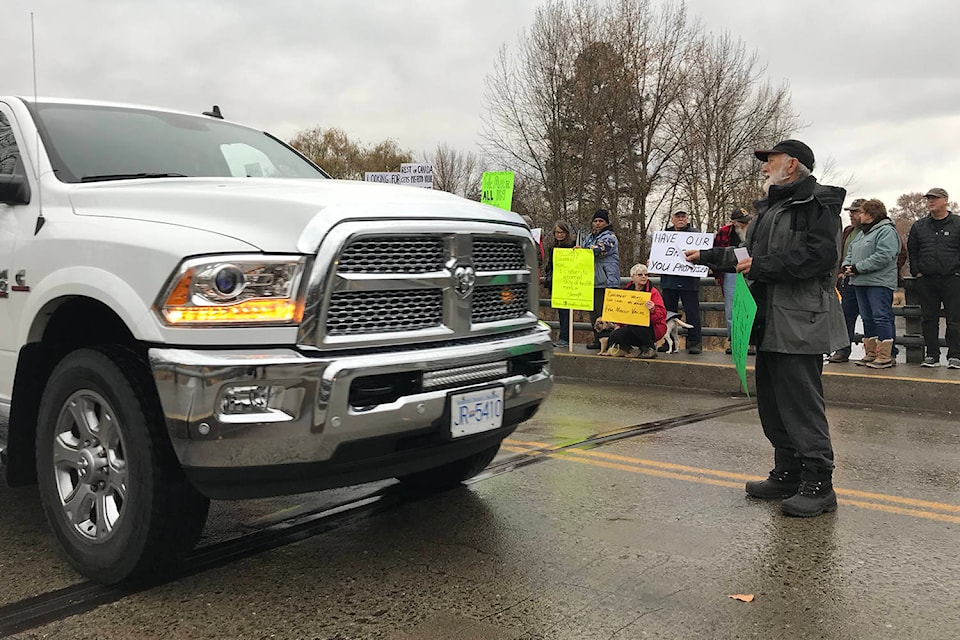Standing on the double yellow centre line in a dark green rain jacket covering layers of warmth, Mel Pulvermacher stared up at a truck’s driver’s side window with a thin piece of white paper in his hand.
“19 months of waiting feels like your boss coming up to you and saying you will be fired,” read the note. “When? We don’t know. Will we give you all your wages? We’re not sure.”
“Read, it,” Pulvermacher said. “What do you think?”
Pulvermacher and other Grand Forks residents whose properties are slated to be bought out under the city’s future plans for flood protection took over the sidewalks and centre line of the 2nd Street bridge in the city on Friday afternoon to raise concern about what they might be offered for their properties, more than a year after the City decided to buy them out.
The bridge, which spans the Kettle River and separates downtown from the city’s Ruckle neighbourhood, also separates an area of the city that will be protected from future floods from an area that will be used to save it.
Approximately 140 properties in Ruckle, where many of Friday’s rally-goers live, are slated to be bought out under the city’s flood mitigation plan in order to be returned to the Kettle River’s natural flood plain.
“We’re not flood victims,” read Ruckle resident Dave Soroka’s sign, the flip side reading, “We’re not asking for favours.”
Rather, residents on the buyout list argue that they are being “sacrificed” to preserve the economic centres of Grand Forks, downtown and in the city’s industrial area. As such, they’ve consistently lobbied government to buy their properties at a pre-flood value.
Friday’s rally was meant to raise awareness of the landowners’ situation with others in the community and to amplify their message to the city: “Fair buyout now,” as several signs demanded.
When news came in June that Grand Forks would have just over $50 million in federal, provincial and municipal funds to implement a flood recovery and mitigation plan, residents on the buyout list learned that their properties would be evaluated at “current market value” – their values post-flood. Since then, flood recovery staff have held meetings with residents to try and come up with in-kind options to help bring buyout values up closer to pre-flood values.
City estimates indicate a discrepancy of approximately $6.6 million between the pre- and post-flood values for all targeted properties combined, while the average loss for property owners subject to buyouts sits at $79,000 per land holding. The median loss sits roughly $10,000 lower at $68,400.
“We want to make sure we come out of this economically whole,” said Soroka when the rally arrived at City Hall on Friday. There, demonstrators were met by Grand Forks mayor Brian Taylor and flood recovery manager Graham Watt.
The City has proposed in-kind options to attempt to lessen the burden of moving – such as supporting moving homes and offering land lease agreements, but many property owners responded by saying that such options would do little to compensate for the discrepancies in paid value for their homes. The City’s latest offer, announced earlier this month, is a straight land swap for interested residents, with the aim to compensate further for land value.
Nevertheless, residents who are frustrated with the time it’s taken since the flood for the city to begin offering land purchase agreements – 18 months and counting – threw questions at Taylor and Watt on Friday about the decisions made to get to this point. Many wondered why precisely the Ruckle area was chose to be bought out, instead of somewhere else along the Kettle River.
Watt, who has been involved with the flood recovery process since water breached city dikes in 2018, sifted through overlapping questions and voices to try and offer answers.
On why Ruckle was chosen to be restored to the floodplain, he explained that engineering reports indicated that it was best to target that area because of the way water could otherwise back up the Kettle River further upstream, as well as the Granby River, which merges near Ruckle. Watt also said that the decision was partly economic, noting that it was cheaper to implement necessary flood mitigation measures with the properties slated for buyouts rather than use part of the low-lying downtown or to add additional protection features.
“If that made it affordable for you then,” one demonstrator yelled over the crowd, “it’s time for you to make it affordable for us.”
The City is currently in the process of hiring a consultant to develop a plan for land acquisition and begin negotiations with affected residents. Under the project’s proposed timeline, buyouts and assistance with moving will happen from now through 2021, with negotiations and payments beginning as early as December. Infrastructure repairs and construction will stretch from 2020 to 2023.
RELATED: Buyout residents ask for expert representation in land negotiations
RELATED: Residents petition for pre-flood value, say Grand Forks could set B.C. precedent
RELATED: Grand Forks mulls in-kind options to support flood buyout residents
@jensenedw
Jensen.edwards@grandforksgazette.ca
Like us on Facebook and follow us on Twitter.
